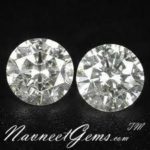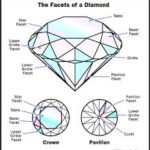Forms, properties and colors of Diamond
Diamond is pure carbon, the element that is also the foundation of life. Carbon has interesting chemical properties that enable it to form a truly vast number of compounds with many other elements. Some of these are biologically active. Another form of pure carbon is the mineral pencils (mixed with clay for this application), and so greasy that it is widely used as a lubricant. Yet the diamond is the hardest known substance, the ad will easily scratch any other material.
Diamond crystals occur in a variety of shapes and forms. The most common shape resembles two four-sided pyramids arranged base-to-base and is known as an octahedron, an eight-sided form. The direction forms seen on diamonds are parallel to the octahedral faces. Other forms seen on diamond crystals include the cube and dodecahedron, the latter an interesting 12-sided form. Some rough diamond crystals are combinations of several of these forms. Also frequently present on diamond crystal surfaces are triangular pits called trillions, believed to have formed during crystal growth.

Salt and pepper diamonds are a distinct group of diamonds that are quickly gaining popularity. After being overlooked for several hundred years due to their flaws, they are now considered to be unique and mystical and are largely popular among younger buyers who are seeking something different from the traditional sparkling diamond.
With multiple design options and shades, these speckled gems can be crafted in any form to suit your needs and the possibilities are endless. We regularly post pictures of our salt and pepper lots at
View this post on Instagram
Fine yellow diamonds with so-called “canary” color make notable gems. Two of the best-known yellow diamonds are the Florentine (137.5 Carats) and the Tiffany (128.5 carats).
Brown and coffee-colored diamonds are not as rare but are seldom seen in the trade. Orange diamonds are popular in South Africa, but few are sold in the United States. Green diamonds are very rare, the most famous being the Dresden green of 48.5 carats. Diamonds are occasionally found in a greenish-yellow hue, sometimes called “champagne color.” Blue diamonds are extremely rare. By far the most famous is the Hope Diamond, weighing 44.5 carats, on display at the Smithsonian Institution in Washington, D.C. This remarkable gem has a somewhat metallic surface luster that reflects light and makes the gem appear darker than it actually is. Pale-blue diamonds are also known, and violet gems are occasionally found. Pale-red and pink diamonds are very rare and although red diamonds have been reported, an intense, fine, red gem gas has not yet been authenticated. Brownish-red diamonds, on the other hand, are occasionally seen in the diamond trade.

